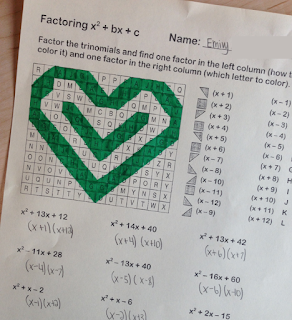This summer, I made these cool doodle notes about graphing quadratics. {It's always exciting when I get to finally use something that I worked so hard on!} This lesson last year took WAY too long, so I expedited things by giving students an partially filled in input-output table and the parent graph.
For each section, I would fill in the first row of each input-output table and then set students loose. I would invite one of my early-finishers to graph the parabola on the board, then I would have the students generalize the rule at their tables. Then I would ask them similar questions like : where would the vertex of x^2 +100 be? What about x^2 - 25? Which graph would be wider y = 10x^2 or y =1/4x^2? My students got it - I really liked how they could compare to the parent graph for each one.
I loved watching students make connections as they created their graphs. and how they discovered how changing part of the equation changed the parabola. They also quickly noticed that the output values repeat once they find the vertex.
Then to practice even more, I used this Graphing Quadratics Station Activity from All Things Algebra to continue graphing parabola. I did not have them move around to stations though. We did Graph A together, so that I could review all that fun vocabulary we just learned and remind them about domain and range. The students were in pairs, so they played rock-paper-scissors to see who had to pick up their first card from the back table. I printed the answer key and stapled it to the back of the card. I made sure to emphasize that students who were caught copying would NOT get any points. But I actually loved having the students have the answer key so they could self-check as they went. I heard great questions from my students, like "How did they get this answer?" Or "I see my mistake." I caught only a handful of students copying out of all 140 of my Algebra students, so I was really impressed. Plus my students felt confident in their graphing skills when they could check-in as they went without constantly calling me over to verify their work. When they finished a card, they would do another round of Rock-Paper-Scissors and then head to the back table to swap out the card.
About 5 minutes before the end of class, I had students draw a large star next to an empty graph spot and complete an exit ticket problem. After class, I sorted them into students who got everything in the problem correct and students that missed part of it. During the next class, I had those with perfect papers help their peers make corrections. I love this quick remediation and empowering my students to teach others.
Next up, we learned how to use the x-intercepts to match equations to their graphs and applies those factoring skills. Check out that lesson here.






















